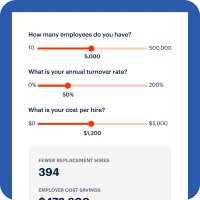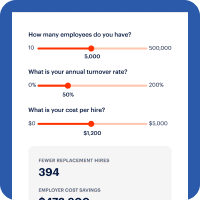In our previous article, we discussed employee retention rate by industry and looked at which industries have the best and worst employee turnover rates. In this article, we take a closer look at generational retention rates, and how the millennial generation fulfills and defies their job hopper stereotype.
For two years now, millennials have been the largest demographic in the U.S. workforce.
However, their reputation preceded their takeover. We’ve long held the stereotypes that millennials are entitled, difficult to please, and notorious for job hopping.
While the two leading stereotypes may be generalizations, job hopping is fact.
According to Gallup Polls, 21% of millennials say they’ve changed jobs within the past year, which is nearly three times higher than generations outside of the demographic. And, if these millennials haven’t hopped already, chances are they are thinking about it.
The same poll shows that 60% of millennials say they are open to a different job opportunity.
Let’s explore why millennials are quick to leave their jobs, what industries have a difficult time attracting millennials, and how we can improve retention with this demographic.
Want a better understanding of how to attract millennials and gen z?
Why are millennials eager to jump ship?
Though everyone’s individual motive is different, there is plenty of research to indicate the variety of reasons millennials hop jobs as often as they do. They:
- Are disengaged a work
- Don’t have a compelling reason to stay
- Feel their company offers too few perks
- Want a better work/life balance
Another observation relates to the education of millennials. Because millennials are set to be the most highly educated demographic, some industry experts argue that the college experience — specifically the ability to change courses and interests on a quarterly or semester basis — can translate into boredom in a job environment. If a job feels monotonous, millennials may shift gears to alleviate their disinterest or cater to their need for continuous learning.
It also may be the case that as digital natives, millennials can more readily find, compare and apply to jobs than any previous generation, which makes job hopping easier than ever.
The cost of turnover
Regardless of the reason for leaving a position, it’s clear that organizations must start deploying more strategic retention strategies to stay productive and profitable. Not to mention the cost of turnover is high.
- For low-paying or entry-level positions, employers can expect to pay 16% of an annual salary. For an employee who earns $10 an hour the expense to replace them would be around $3,328.
- For midrange positions, an employer can expect to pay around 20% of an annual salary. For a salaried employee who makes around $40k, the cost to replace them would be around $8,000.
- For highly educated positions like those at the executive level, organizations can expect to pay up to 213% of an annual salary. To replace an employee who makes roughly $100k, the cost to replace them would be around $213,000.
Millennials by industry
Interestingly, research shows that even though millennials are the largest demographic in the workforce, they also have the highest rates of unemployment and underemployment in the U.S., which makes them increasingly valuable in a tight labor market where there are more jobs than available workers.
By the numbers: Where are millennials employed?
As research shows, millennials flock to specific industries while leaving others high and dry:
- 64% of millennials said they wouldn’t work in construction even if they earned $100,000 or more.
- According to the Pew Research Center, only 4% of millennials are interested in working in the insurance industry.
- Manufacturing jobs are taking a hit when it comes to millennial employees. According to a study conducted by Paycheck, manufacturing has one of the lowest percentages of millennial employees (31.8%) of all industries.
- Leisure and hospitality have a high percentage of millennial employees (49.9%), but also pay the lowest wages ($15.51/hour).
- 1 in 4 millennials is a part of the gig economy, which includes freelance, part-time and/or temporary work.
- Education, health services and construction have the largest gaps between male and female workers.

How to attract and retain millennial employees
As more boomers being to reach retirement age, industries that are lacking millennials in their workforce need to be more creative when it comes to attracting and retaining talent to keep their industries alive.
Consider the following strategies.
Cater to digital natives
Millennials are considered digital natives, that is to say, they grew up with instant access to any type of information imaginable. Gallup estimates that 85% of millennials access the Internet from their phones, and it’s not just for the news or social media. The same poll suggests that eight in 10 millennials used the internet in the last 30 days to:
- Manage their finances
- Pay bills
- Shop online
- Watch or listen to online content
What’s clear is that millennials value technology and companies that are in touch with these needs may have an upper-hand when it comes to attracting and retaining millennials.
DailyPay, for example, noticed this trend and responded with a texting service that allows users of the service to interact with payroll via a mobile experience. Users simply text emojis to receive their earned but unpaid pay, instantly. This level of service resonates with tech-savvy millennials, while also offering a unique benefit.
Give them a reason to come back
Recruiters that must hire seasonal workers try to rely on the “boomerang” tactic. In a nutshell, boomerang hiring means that employees have such a great experience working with a company, that next time seasonal hiring occurs, the employees want to come back.
This tactic isn’t widely-used when recruiting for permanent positions, but maybe it should be.
Once an employee leaves, most managers are quick to burn bridges. However, in a tight labor market —when competition is stiff and talent is hard to come by — looking at employees who voluntarily left an organization is a unique recruiting strategy.
Of course, in order to make your patch of grass the greenest, you need to find ways to differentiate from the competition and keep former employees invested in your organization.
Focus on wellbeing
Regardless of industry or rank, most U.S. workers face unprecedented levels of stress. Specifically, 40% of U.S. workers say they experience stress at work according to Deloitte. As a result, employees feel a decline in:
- Workplace productivity
- Health
- Family stability
Hourly workers often experience stress due to schedule inflexibility, while white-collar workers feel stress when they are unable to disconnect from their jobs.
From a business perspective, the negative effects of stress lead to increased absenteeism, disengagement, and eventually turnover all of which impact a company’s bottom line. To remedy the issue, many organizations are focusing on comprehensive well-being as a retention strategy, which focuses on health and finances. The results are incredible.
Employers who offer DailyPay as a financial wellness tool:
- Reduce turnover by 41%
- Fill open positions 52% faster
- Reduce absenteeism by 26%













